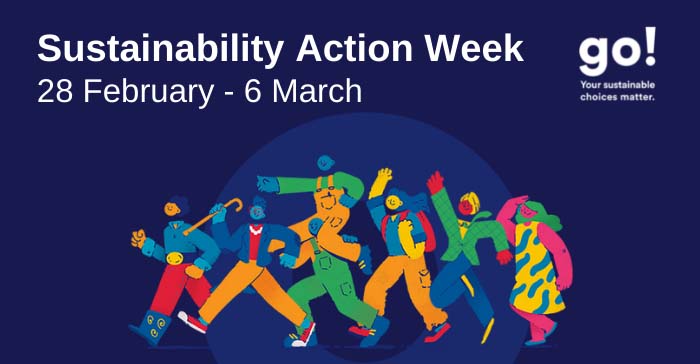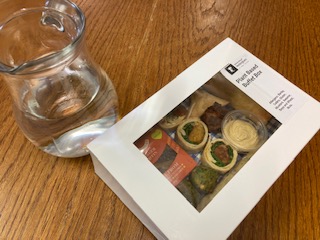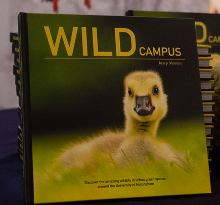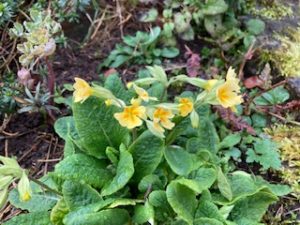
March 3, 2022, by Ryan Neal
The Sustainability Challenge – day four
In celebration of Sustainability Action Week, we’ve challenged two of our senior leaders – Andy Nolan, Director of Development and Sustainability; and Professor Sarah Speight, Pro-Vice-Chancellor for Education and Student Experience – to spend the week living as sustainably as possible. Each day they will be chronicling their experience and sharing some tips so make sure you check back regularly.
Sarah
Learning from the next generation
It’s an early start this morning. After a day of working from home, it feels good to be walking down the hill into town for the bus. In just two days, I can see the difference in the green spaces on my route. The snowdrops, the daffodils and the primroses are all opening. Once in the office, I have a healthy balance of face-to-face and virtual meetings. I’ve planned ahead and thought about what I need for each meeting. I chose not to carry my laptop but have taken care to print the few hard copy papers I need in ‘two pages per side’, and ‘print both sides’ mode.
If there’s a theme to Thursday, it’s listening to students. We know that students care deeply about the health of the planet and want older generations (and specifically politicians) to do more. Greta Thunberg isn’t a one-off. Advance HE have some survey data showing that students link learning about sustainability to graduate outcomes – they recognise that there are great careers to be had and they want to work for ethical employers who are responding to the climate emergency. But students don’t always see how sustainability relates to their degree courses.
A few years ago, I ran some focus groups across the three Nottingham campuses in the UK, China and Malaysia. The purpose was to gather data about student understanding of sustainability and their views on whether it should be included in the curriculum of more courses. I found that there were six elements that appeared to contribute to students’ beliefs and attitudes: previous educational experience, personal interests, cultural and family background, current involvement in sustainability-related activities, peer influence and the subject(s) being studied.
For some students, the connection to their studies was obvious:
“As I am an engineering student it’s underlined in almost all our modules. Sustainability is one of the key features of being an engineering student. It’s always featured in the lessons, in the classes, the lectures so we are constantly being reminded of it.”
“Sustainability and the environment, with respect to business, can be in terms of incorporating ethical and environmental standards within the practices of business. That’s how we’ve been taught to look at it…”
For others, the link wasn’t clear, but they still wanted to learn:
“I think what should be considered on all courses is something that relates to it. So you can always relate this whole issue of sustainable development; you can link it to business; you can link it to engineering; you can link it to art; you can link it to any other social science. I think it would be nice if lecturers could incorporate one aspect, it doesn’t have to be big but… just awareness for students to realise that there is a reason behind all the work that is done to sustain our resources.”
And for some of the students, there was a compelling connection between sustainability and the challenges facing their home communities:
“I’m from Kenya. At the moment the north of our country is facing one of the biggest food crises and starvation. Those are things that are personal to you – you just relate more to it.”
“For those students who come from my province in China, they know very well the pressure of water shortage, so for them it is almost like their tradition or custom to do that, to save water.”
Understanding how the climate emergency is affecting some of our students (and staff) now is a powerful reminder to those of us in the UK not to be complacent.
These students accepted their individual responsibility, but also wanted their university to be supporting sustainable behaviours across all its activities. I think that their views are well represented in where we are now, in 2022. We’ve got an ambitious carbon management plan, as Andy explained on Tuesday, and our University strategy commits us to making a strong contribution to meeting the United Nations’ Sustainable Development goals.
Returning to what’s been happening today, I’ve been in lots of meetings about how we support students to achieve their best. I’ve had a ‘Joint Academic Board’ meeting with the University of Nottingham International College (UNIC) to talk about the progress of students taking pathway courses at the college to prepare them for one of our degree courses. I’ve also had a meeting of the Education Planning Group (EPG) – this is the group of faculty and professional services leads who have been meeting regularly throughout the Covid-19 pandemic. Two years on and we still have very tough decisions to make – including about how we best support students impacted by the dreadful situation in Ukraine who are due to take assessments in the next few months.
 The EPG meeting was in-person and over lunch. I asked Andy what happens to any food left over from meetings and he checked with colleagues in catering. There isn’t that much left over from catered events now as attendees tend to take it home with them. Lunches are now packaged in individual cardboard boxes rather than communal plastic trays. This is about Covid as well as about limiting waste but it’s also making it easier for us to take food away for later. I am glad I came prepared for leftovers– I’ve got two big bags with me!
The EPG meeting was in-person and over lunch. I asked Andy what happens to any food left over from meetings and he checked with colleagues in catering. There isn’t that much left over from catered events now as attendees tend to take it home with them. Lunches are now packaged in individual cardboard boxes rather than communal plastic trays. This is about Covid as well as about limiting waste but it’s also making it easier for us to take food away for later. I am glad I came prepared for leftovers– I’ve got two big bags with me!
It’s been an intensive day on campus and I’m glad to be heading home on the bus. But my working day isn’t over yet. After dinner, I’ll be turning back into a student myself as I have my weekly two-hour Greek class. Καλησπέρα και καληνύχτα! (Good evening and goodnight!)
Andy
Birds, bees, bats and butterflies… and, er… books
Not only do we have a climate crisis, we have a biodiversity crisis. Urbanisation, intensification, and a changing climate are making it difficult for native species to adapt quickly enough. As a result, we’re seeing less biodiversity. A healthy planet has an abundance of species in a stable state – sadly there has been a marked decline. But you can do something about it.
During lockdown we made a conscious effort to ensure there are a variety of plants in our garden to attract birds, bees, butterflies and bats – and it was great to see them last year. Planting bee-friendly plants isn’t difficult – they like flowering plants throughout the year, so try some wildflowers, or buddleia or herbs like rosemary. Where there are insects and fruits you’ll find birds so variety is the answer. Choose flowers, shrubs and trees that offer those at different times of the year so you are able to support them through all seasons. Through the spring, summer and autumn last year we saw many different species of birds in our garden including coal tits, blue tits, sparrows (lots of sparrows), jays, blackbirds, pigeons (there’s a regular pair), robins, magpies, and chaffinches. We also saw the occasional owl although it was easier to hear than see them at night. There are bats out there too and watching them sweeping the skies of insects at dusk is always fun. Sadly, there was a noticeable lack of butterflies – a consequence of a late dose of frost that may well have had an effect.
Keeping an eye on what happens during the day is one thing but seeing what happens at night has become something of a hobby for me since lockdown and, with the aid of infrared cameras, I know that we’ve been regularly visited by several foxes and badgers even in the suburban environment of Sheffield (click the links for some footage!). These species have adapted to living close by human beings and busy roads and are, apparently, thriving. Living in a busy but green suburb with thousands of trees, it’s great to see and hear these species although they can be shy and good at hiding.
As spring approaches we’ll be creating those wilder spaces in our garden that attract a variety of species, hoping that our efforts will not only support the birds, bees, bats and butterflies but will also ensure the local apiary produces more excellent honey!
 Did you know that today is World Book Day and World Wildlife Day? It seems sensible then to remember our #BeastsofUoN and the wonderful book produced by one of our Life Sciences MSc Students, Jusep Moreno, Wild Campus which captures some of the amazing wildlife we have on campus. You can buy a copy of it online too. Our landscaping team at the university have created some amazing environments where wildlife thrives. If you’re in the right place at the right time, you could see many different bird species – from the tapping of a woodpecker, to the swooping speed of a peregrine. On the ground you might see a badger or a fox at night too. We produce guides to the plants and animals you can find on Jubilee Campus and there is a free detailed University Park Gardens Guide and Tree Walk available from any of the gatehouses or from Lakeside Arts Centre.
Did you know that today is World Book Day and World Wildlife Day? It seems sensible then to remember our #BeastsofUoN and the wonderful book produced by one of our Life Sciences MSc Students, Jusep Moreno, Wild Campus which captures some of the amazing wildlife we have on campus. You can buy a copy of it online too. Our landscaping team at the university have created some amazing environments where wildlife thrives. If you’re in the right place at the right time, you could see many different bird species – from the tapping of a woodpecker, to the swooping speed of a peregrine. On the ground you might see a badger or a fox at night too. We produce guides to the plants and animals you can find on Jubilee Campus and there is a free detailed University Park Gardens Guide and Tree Walk available from any of the gatehouses or from Lakeside Arts Centre.
As I mentioned in an earlier blog, the Hedgehog Friendly Campus scheme aims to raise awareness of the plight of thw hedgehog while taking practical steps to improve habitats and circumstances for hedgehogs across university campuses. Hedgehog Friendly Campus is a campaign that aims to arm a new generation of hedgehog champions with the skills and knowledge to give the dwindling hedgehog population a fighting chance. It will educate our staff, students and the surrounding community about hedgehog-friendly behaviour, both on campus and at home. The Hedgehog Friendly Campus project is funded by the British Hedgehog Preservation Society and runs nationally. If you’re interested in getting involved, follow the links above.
Find out how Andy and Sarah got on on day one, day two, day three and day five.
No comments yet, fill out a comment to be the first


Leave a Reply